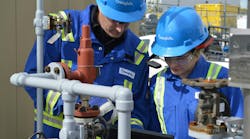Frank Caprio is Hose Master’s corporate trainer, major market specialist, and dean of hose master university. Mr. Caprio has more than 35 years of experience in hydraulic, industrial and metal hose and expansion joint products and their applications. Frank is a member of NAHAD, AIST, ASME, and ASM International.
Q: For what sort of fluid handling applications is metal hose generally a good fit?
A: Corrugated metal hose is ideal for use in applications where extremely high or low temperatures (either internal or surrounding the hose) are encountered. Corrugated metal hose is used for steam transfer, high-heat environments, such as steel mills and furnaces, as well as for the transfer of cryogenic liquids. Corrugated metal hoses are used in critical fire-safety applications, such as fire sprinkler systems, flexible connectors for piping on underground gasoline storage tanks, and barge loading/unloading systems.
Corrugated metal hose is also a good choice for applications where corrosion is a concern, whether from corrosive media or environments. The hose and outer wire braid can be made using various alloys to suit corrosive applications, such as those found in refineries and chemical plants.
The geometry of the corrugations gives metal hose excellent hoop strength, providing superior resistance to collapse in vacuum applications or when exposed to high external pressures, such as those found in autoclave or deep sea applications. Corrugated metal hose does not permit permeation of the media through the hose wall, as do nonmetallic constructions, which is an important characteristic in applications where corrosive or combustible media are being conveyed, or where high vacuum levels must be maintained.
Corrugated metal hoses offer flexibility in end fitting configuration, as they are able to accept a wide variety of end fittings in complex arrangements. Virtually any metal fitting that can be welded or brazed can be incorporated into a corrugated metal hose assembly. Also, corrugated metal hoses permit the direct attachment of special or customer-specific fittings and flanges. A metallic hose with welded fittings is also electrically conductive, preventing the buildup of static electricity. Nonmetallic hoses may require special construction or fabrication techniques to ensure electrical continuity. In addition, corrugated metal hose is used in tight installations, as the end fittings are typically more compact than barbed fittings used on nonmetallic hoses. Shorter fitting lengths allow for longer “live” hose lengths per assembly, maximizing flexibility.
Q: For what sort of applications is metal hose generally not a good fit?
A: Because metal hose is constructed from welded components, it should not be used for the transfer of food or medical grade materials. The welded hose-to-fitting connections have the potential to harbor bacterial growth, which may contaminate the media. Also, a corrugated metal hose is not resistant to abrasive media unless fitted with a flexible, abrasion-resistant interlocked hose liner.



